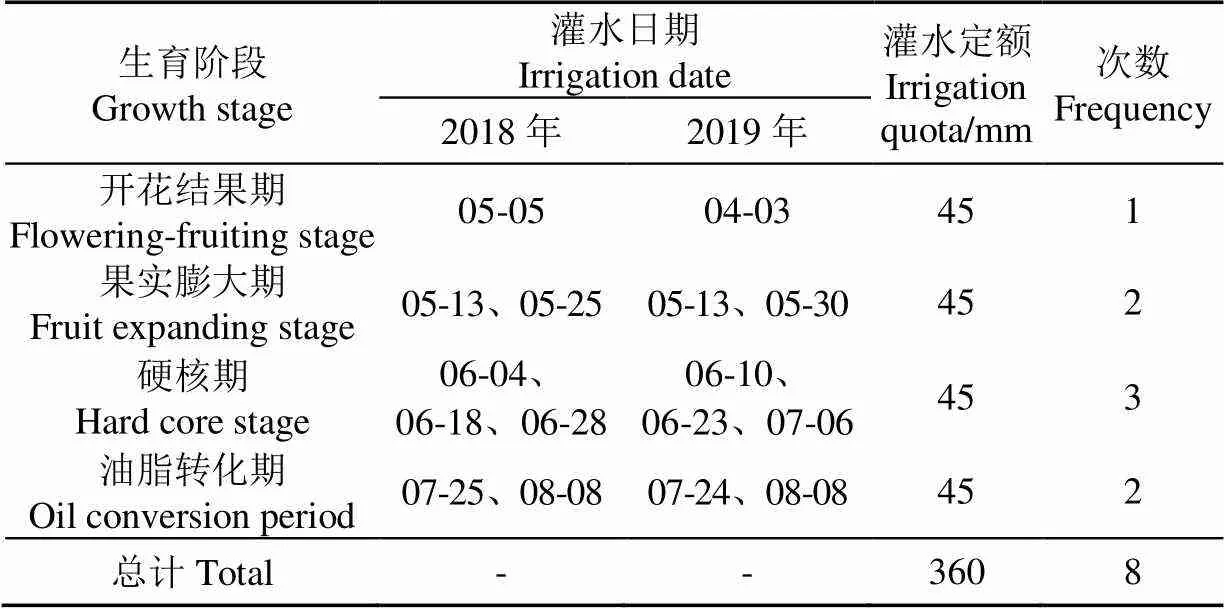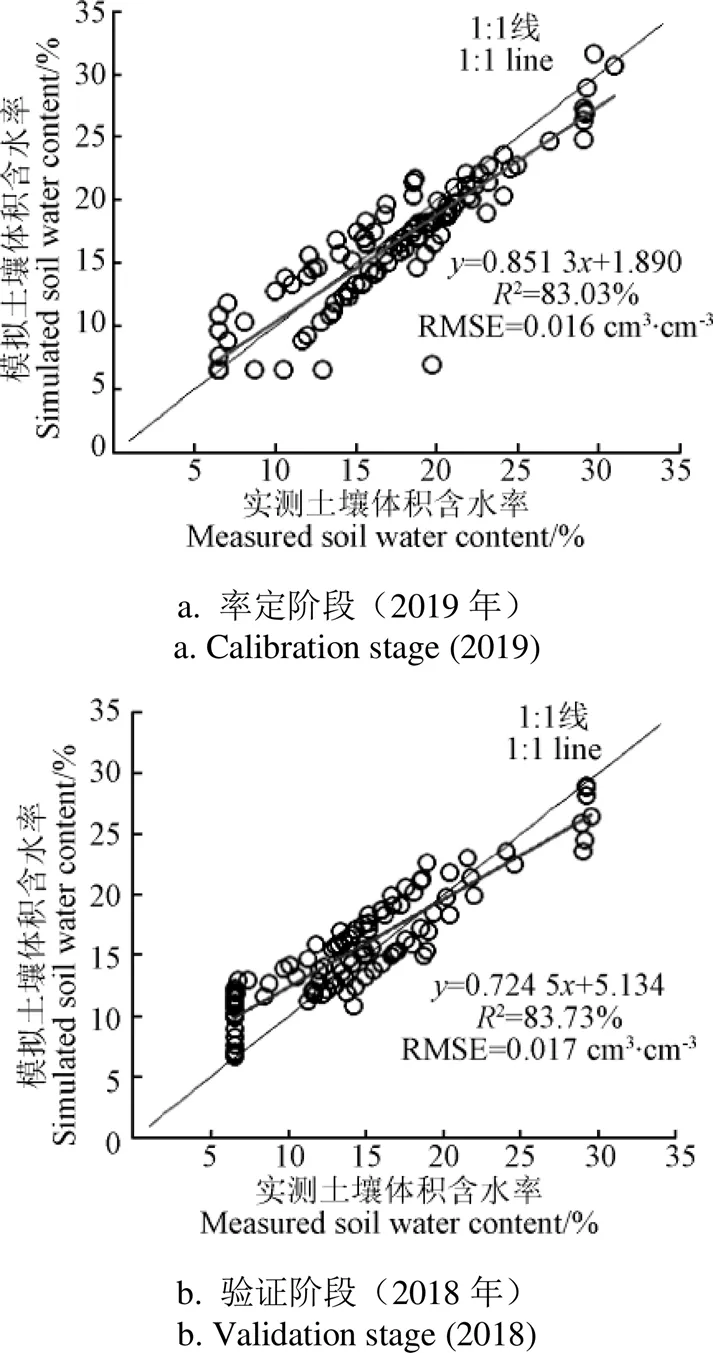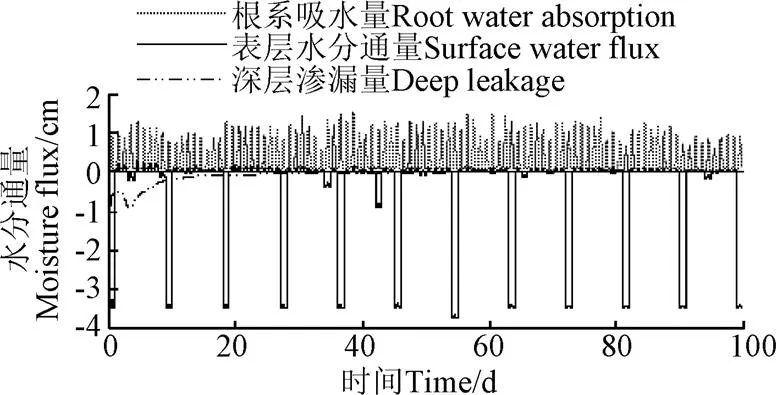新疆干旱区成龄核桃滴灌制度优化
2020-09-20虎胆吐马尔白米力夏提米那多拉
虎胆·吐马尔白,焦 萍,米力夏提·米那多拉
新疆干旱区成龄核桃滴灌制度优化
虎胆·吐马尔白,焦 萍,米力夏提·米那多拉
(新疆农业大学水利与土木工程学院,乌鲁木齐 830052)
科学合理的灌溉制度是提高灌水利用效率的主要因素。该研究采用HYDRUS-2D模型结合寻优模型相结合的方法,研究新疆核桃滴灌优化制度。利用2018年和2019年定点观测土壤水分数据进行模型率定与验证;利用模型设定128种情景进行模拟研究,分析南疆干旱区滴灌成龄核桃不同灌溉制度下的深层渗漏和水分胁迫。应用模型结合灌溉制度寻优函数探求滴灌条件下成龄核桃各灌溉制度土壤水分通量。结果表明:HYDRUS-2D模型模拟土壤含水率精度较高,2为83.03%~83.73%,均方根误差在0.016~0.017 cm3/cm3范围。根据模型模拟结果,推荐新疆干旱区核桃滴灌制度为灌水定额35 mm,灌溉11次,灌水周期9 d,灌溉定额385 mm或者灌水定额50 mm,灌溉7次,灌水周期14 d,灌溉定额350 mm,在以上滴灌制度下,可最大限度减少农田水分损失和提高灌水利用效率。该研究可为制定南疆滴灌条件下成龄核桃适宜灌溉制度提供参考。
灌溉;优化;新疆;干旱区;核桃;滴灌制度;HYDRUS-2D
0 引 言
对处于典型干旱区的南疆地区来说,灌溉是决定其作物产量的关键因素[1]。适宜的灌溉制度不仅可以维持作物产量,而且可以提高作物水分利用效率,实现有限水资源高效利用。作物灌溉制度包括全生育期灌水次数、灌水周期、灌水定额和灌溉定额。确定灌溉制度的常用方法为小区试验[2],但大田试验耗时费力,易受天气影响。因HYDRUS模型对土壤水盐热运移模拟的精确度高,模型可靠等优点[3-6]。很多学者都将其用于田间土壤水分的运移模拟[7-9]及灌溉制度的研究[10-14]。如,杨鹏年等[15]对干旱区不同地下水埋深膜下滴灌灌溉制度做了模拟研究,蒋光昱等[16]对疏勒河流域的辣椒灌溉制度做了优化分析,得到了畦灌条件下的灌溉制度,刘晓媛等[17]模拟冬小麦夏玉米节水灌溉模式下的土壤水分运移,得出了夏玉米、冬小麦季的灌溉量,王在敏等[18]对棉花微咸水膜下的滴灌灌溉制度做了优化。在农田中,作物生长耗水量主要源自降雨和灌溉,农田水分消耗包括蒸发、蒸腾和深层渗漏等[19]。HYDRUS-2D模型中包括的土壤水分动力学模型、根系吸水模型和蒸发蒸腾模型3个模块可以精确模拟蒸发、蒸腾和深层渗漏。以深层渗漏量较小又无水分胁迫为判断标准,减少无效农田水分消耗,提高灌溉水利用效率,可以解决大田试验费时耗力和南疆成龄核桃树灌溉水利用率低等问题。因此,通过模拟计算不同灌溉制度下的深层渗漏量与作物水分胁迫量确定最优灌溉制度,利用模型研究作物耗水规律,不受其研究地域影响,大大缩短试验周期,增加试验变量,可排除干扰因子,最终得到试验因素间的关系[20]。本研究拟将HYDRUS-2D模型与成龄核桃田间滴灌灌溉制度寻优相结合,模拟各灌溉制度情景方案下的田间水分通量来选择最适宜的滴灌灌溉制度,以期为南疆滴灌成龄核桃灌溉提供理论指导和科学依据。
1 材料与方法
1.1 研究区概况
研究区位于新疆阿克苏地区红旗坡农场,地处天山南坡中段,塔里木盆地边缘。地理坐标为80°20′E,41°16′N,该地海拔1 130 m,属暖温带干旱性气候,年内及昼夜气温值变化较大,多年平均太阳总辐射量544.115~590.156 kJ/cm2,多年平均日照时数2 855~2 967 h,无霜期达205~219 d,多年平均降水量42.4~94.4 mm,多年平均气温11.2 ℃,年有效积温为3 950 ℃。试验区面积6 666.7 m2,0~120 cm土壤平均干容重1.39 g/cm3、田间持水量19.44%。地下水埋深在6 m以下,水质符合灌溉水质标准(GB5084-2005)。
1.2 试验设计
试验样本树为11 a成龄核桃树,品种为“温185”,属早熟纸皮核桃。种植密度为1 667株/hm2,株行距为2 m×3 m。每年4月初开始进入新的生育周期,8月下旬进行采收。采用地表滴灌充分灌溉,灌水次数为8次(表1)。模拟基础数据为2018年、2019年2 a的实测数据。生育期内对果树进行常规施肥(沟施及随水施肥),氮肥400 g/株、磷肥200 g/株、钾肥200 g/株,定期除去杂草。滴灌带为新疆坎儿井公司生产,滴头流量为3.2 L/h,滴头间距20 cm。滴灌带距树40 cm,一行两管式铺设。

表1 核桃灌溉制度
1.3 试验测定项目
试验小区为无底自由排水边界的测坑(长3 m,宽2 m,高4 m),测坑内核桃树种植与大田一致,测坑内土体为原状土,土壤试验设定3组重复(3个测坑)。试验测定项目如下:
1)土壤含水率采用剖面土壤水分传感器(TRIME-PICO-IPH,IMKO Inc.,Germany)测定。水平方向每40 cm设监测管,测定距离150 cm;垂直方向每10 cm设监测点,测定深度100 cm。
2)棵间土壤蒸发采用微型蒸渗仪测定,每天10:00左右测定1次,利用精度0.01 g的电子天平称质量。微型蒸渗仪用直径110 mm的PVC管制成,高度15 cm,为保持与田间土壤水分的交换,底部用1 mm间隔的网包扎封底。将微型蒸渗仪放入预埋管中,顶部与地面平齐。预埋管为直径125 mm的PVC管,高度20 cm。每2~3 d更换1次微型蒸渗仪中的土壤。
3)根长密度采用分段分层掘进法,采用Delta-T scan(CB50EJ,Cambridge,UK)软件计算根长密度。以30 cm×30 cm×10 cm的单元体取样,取至行间150 cm,深度取至100 cm止。将核桃根长密度在核桃树行方向进行平均,得到核桃树二维根长密度分布函数。
4)叶面积指数(Leaf Area Index,LAI)采用Hemiview冠层分析系统(Delta-T,Self Levelling Mount SLM8,UK)每月对核桃树冠层定期(15 d)测定1次,测定位置距树干80 cm,选择东西南北4个方向择定,取四个方向核桃树叶面积指数的平均值。
5)气象数据根据试验站架设的微型气象站(Watch Dog2000,Spectrum,USA)测定,每30 min记录1次,包括太阳辐射、气温、相对湿度、风速及降雨量等。2018年和2019年核桃生育期内有效降雨、灌水量及日均蒸腾速率如图1所示。

图1 2018和2019年各因子动态变化
2 模型构建与验证
2.1 模型构建
2.1.1 土壤水分运动方程
采用HYDRUS-2D V 2.X版本软件,二维土壤水分运动方程表示如下:

式中为水平向坐标,cm;为垂向坐标,cm;为时间,h;为土壤体积含水率,%;()为土壤水分运动扩散率,cm3/h;()为非饱和土壤导水率,cm/h;为根系吸水汇源项,1/h。
土壤水分运动方程的初始条件:以灌水前测定的剖面土壤含水率为初始含水率,水平向坐标同一土层内取平均值。
θ(,,0)=0n,0≤≤150 cm,0≤≤100 cm,=1,…,10(2)
式中θ为第层土壤实测体积含水率,%;0n为=0时土壤体积含水率,%;为土层数,共10层。
边界条件设定:不灌水时,上边界为大气边界。上边界的其余部分(R≤≤150 cm)始终为大气边界。R为饱和半径,本研究中实测饱和半径为4.2 cm。大气边界土壤水分运动主要取决于降水或地面蒸发,为第一、二、三类边界,随着时间变化,可在各类边界之间相互转化。考虑地下水埋深大于6 m的情况,下边界假定为自由排水边界条件。左右边界(=0、150 cm)处,假定为不透水边界,即零通量边界[23]。
上边界条件:

下边界条件:

左右边界条件:

式中()为蒸发强度,cm/min;()为入渗强度,为滴头流量与单位长度滴灌管表面积的比值, cm/min,。
2.1.2 根系吸水模型
式(1)中的采用Feddes等[21]提出的根系吸水模型计算:
=()S(6)

式中()为土壤水势指定相应函数(0≤≤1);S为潜在根系吸水速率,1/h;(,)为根长密度分布函数;S为与蒸腾相关的土壤表面宽度,cm;T为潜在蒸腾强度,cm/h。

式中X和Z为根系在和方向上最大根系伸展深度,cm。采用2018年根系实测数据利用DPS软件进行二次多项式回归拟合,获得拟合参数P为1P为1.20为45.83x为1.78,拟合精度2为0.87。
根据试验地土壤质地和机械组成,使用HYDRUS-2D软件自带的Rosetta软件通过人工神经网络预测得出各土层水力特性参数(土壤残余含水率、土壤饱和含水率、饱和导水率、模型参数和)。以2019年土壤含水率数据为率定数据,以2018年土壤含水率数据为验证数据,得到优化后的参数见表2。其中颗粒组成为实测结果,美国农业部土壤质地三角形筛分土粒,进行土壤颗粒划分。

表2 模型参数求解结果
采用Penman-Monteith公式计算参考作物蒸腾量[22],公式如下:

式中ET0为参考作物蒸腾量,mm/d;R为作物表面净辐射,MJ/(m2·d);为土壤热通量,MJ/(m2·d);为平均空气温度,℃;2为2 m高度风速,m/s;(e−e)为水汽压差,kPa;为水汽压-温度关系曲线的斜率,kPa/℃;为湿度计常数,kPa/℃;900为转换系数。
作物潜在蒸散量采用单作物系数法计算,公式如下[22]:
ETc=KET0=T+E=ETc(1−e−0.6LAI)+ETce−0.6LAI(10)
式中ETc为作物潜在蒸散量,mm/d;K为实际作物系数,根据文献[2]确定,%;T单位为mm/h;E为土壤潜在蒸发,mm/d;LAI为叶面积指数,%。农田耗水量计算采用水量平衡法计算,其中地下水补给量为0。
2.2 灌溉制度寻优模型
灌溉制度寻优目标函数如下:

式中DP为深层渗漏量,mm;WS为水分胁迫量,mm;为灌水时间间隔(=5,6,…,20),d;为灌水定额(=30,35,…,65),mm;为寻优目标函数值,值越小,灌溉制度越优。
通常情况下,当土壤含水率小于60%的田间持水量时,会产生水分胁迫影响。核桃生育期内水分总胁迫量计算公式如下[16]:


3 结果与分析
3.1 HYDRUS-2D模型模拟结果验证
土壤体积含水率实测值与模拟值比较如图2所示,2019年率定阶段均方根误差(Root Mean Square Error,RMSE)为0.016 cm3/cm3,2=83.03%;2018年验证阶段RMSE为0.017 cm3/cm3,2=83.73%。率定阶段与验证阶段精度均较高,HYDRUS-2D模型模拟结果效果较好,表明模型可以用于土壤含水率模型。率定结果见表2。

图2 土壤含水率模拟值与实测值对比
3.2 基于模型模拟结果的分析
3.2.1 现行灌溉制度评价
通过表1灌溉制度下2018和2019年的实测数据(气象数据、叶面积指数、土壤含水率、棵间土壤蒸发、根系分布数据和土壤基本参数等)与HYDRUS-2D模型对农田水分通量模拟,可得到核桃耗水特性与田间水分通量(表3)。

表3 2018和2019年核桃耗水特性与田间水分通量
如表3所示,南疆成龄核桃2018年和2019年生育期耗水量为634.15~726.90 mm,日均耗水强度为5.51~6.29 mm/d,这与赵经华等[2]通过不同微灌技术下成龄核桃生育期耗水总量在585.6~840.3 mm间变化结论基本一致。成龄核桃各生育期内日均耗水强度由大到小分别为:油脂转化期(6.87~7.64 mm/d)、硬核期(6.14~7.55 mm/d)、果实膨大期(5.29~5.93 mm/d)、开花结果期(3.72~4.02 mm/d)。生育期内水分总胁迫量为−25.57~−118.52 mm,深层渗漏量总量为11.02~109.75 mm,二者之和为总耗水量的19.96%~21.33%。
3.2.2 灌溉制度优化
从4月30日开始第1次灌水。在设定灌溉方案时参考当地核桃需水量来确定灌溉制度范围。本研究共设定8个灌水定额(30~65 mm)、16个灌水时间间隔(5~20 d),共计128种灌水定额和灌水时间间隔不同的灌溉制度(M1~M128,表4)。

表4 核桃灌溉制度集
将基于2019年数据率定获得的土壤特性参数、基于式(9)计算出的蒸散量值、基于式(8)计算获得的参数值输入HYDRUS-2D模型,对128组灌溉制度进行数值模拟,可获得农田耗水量、根系吸水量、深层渗漏量和水分胁迫量模拟值(图3)。由图3可知,农田耗水量范围在149.0~1 284.5 mm之间,深层渗漏量范围在50.77~928.88 mm之间,当地地下水深度超过6 m,不考虑地下水补给。各灌溉制度的农田耗水量和深层渗漏量均随灌水间隔增大而减小。根系吸水量在灌水定额和灌水时间间隔双变量变化因素下,根系吸水量随灌水时间间隔变化幅度逐渐减小:如灌水定额为30 mm时,根系吸水量范围为245.02~406.37 mm。而灌水定额为65 mm时,根系吸水量范围为307.80~400.09 mm。
模型模拟结果耗水量与深层渗漏量跨度较大,因此寻优时剔除深层渗漏量和水分胁迫量大于作物耗水量1倍的灌溉制度。结合式(11)所得图3可知,寻优目标函数值越接近零值线,则此灌溉制度灌溉水浪费最少。通过对不同灌水定额条件下农田中寻优目标函数值的比较,可以得出如表5所示的较佳的8种灌溉制度,其中以M34的寻优目标函数值最低,其次为M77,随后为M94、M112、M51、M119、M60、M25。M34灌溉制度的寻优目标函数值为农田耗水量的0.002倍,M77灌溉制度的寻优目标函数值为农田耗水量的0.004倍。若考虑目标函数值最小,则M34灌溉制度最优;若考虑农户田间工作量应拉大灌溉时间,则M77灌溉制度更适宜。

图3 各参数随灌水间隔的变化

表5 核桃灌溉制度优选
注:占比指寻优目标值与农田耗水量的比值。
Note: Proportion refers to ratio of target value for optimization to farmland water consumption.
以2019年干旱年为例进行模拟,优化灌溉制度(M34和M77)下的农田水分通量模拟结果如图4所示,M34和M77灌溉制度下,干旱年水平下水分胁迫量和深层渗漏量均较小。综上,推荐南疆地区成龄核桃滴灌灌溉定额350~385 mm,灌水定额35~50 mm,灌溉次数7~11次,灌水间隔9~14 d。

a. M34
b. M77
注:0指每年灌水开始日期(04-30)。
Note: 0 refers to the date when irrigation starts (04-30).
图4 核桃灌溉制度模拟寻优结果
Fig.4 Optimization of irrigation scheme for walnut based simulation results
4 讨 论
试验观测与模拟期为2018年4月30日-2018年8月9日,2019年4月30日-2019年8月9日,生育期内有效降雨及日均蒸腾速率如图1所示,2018年与2019年2 a降雨量差异显著,2018年观测模拟期内总降雨量为133.3 mm,而2019年阿克苏地区雨季提前至4月观测模拟期内总降雨量只有24.8 mm。取降水量距平百分率[−10%, 10%]为正常年份,[10%, 30%]为偏湿年和[−30%, −10%]为偏干年,大于30%为湿润年,小于−30%为干旱年;以阿克苏河流域15世纪—20世纪平均值40 mm降雨量为标准[23],小于28 mm为干旱年,[28, 35] mm偏干年,(35, 44] mm是正常年,(44, 52] mm是偏湿年,大于52 mm是湿润年。可以判断出2018年为湿润年,2019年为干旱年。模型率定采用干旱年数据,而模型验证采用的是湿润年的数据,2 a模型模拟精度都较高。这表明,不管是模拟干旱年还是湿润年,HYDRUS-2D模型模拟土壤水分状况的可靠性均较高,因此,根据本文结果,基于HYDRUS-2D模型模拟和寻优结果获得的灌溉制度对干旱年和湿润年均具有适用性。这需要进一步的试验验证。
HYDRUS-2D模型模拟精度高,能较好地模拟农田土壤水分通量的动态变化[24-26]。本文采用HYDRUS-2D模型模拟了不同灌溉情景方案下的深层渗漏量和水分胁迫量。而且,将模拟结果用于寻优模型进行灌溉制度优化,为果园灌溉制度优化提供了一种有效的方法。
成龄果树根系分布较为复杂,且根系分布会随时间变化。为提高灌溉制度模拟结果的可靠性,今后应在各生育期均对根系取样,建立随时间变化的二维根系吸水模型,灌溉制度优化设计时分不同生育阶段进行,以实现更加精准的优化灌溉制度。后续试验也可通过采用智能土壤墒情仪对土壤水分进行实时监测,或结合优化算法使灌溉制度优化系统更加精准。
5 结 论
1)基于田间试验数据验证HYDRUS-2D模型表明,模型对土壤含水率的模拟精度较高,2为83.03%~83.73%,均方根误差在0.016~0.017 cm3/cm3范围,表明HYDRUS-2D模型可用于滴灌核桃园土壤含水率的模拟。
2)基于模型模拟及寻优模型结果,推荐南疆地区成龄核桃的滴灌制度为灌水定额35 mm,灌溉次数11次,灌水间隔9 d,灌溉定额385 mm或者灌水定额50 mm,灌溉次数7次,灌水间隔14 d,灌溉定额350 mm。
可见,HYDRUS-2D模型结合寻优方法用于灌溉制度优化时具有潜在优势,研究可为果树灌溉制度优化提供参考。
[1] 王军,李久生,关红杰. 北疆膜下滴灌棉花产量及水分生产率对灌水量响应的模拟[J]. 农业工程学报,2016,32(3):62-68.
Wang Jun, Li Jiusheng, Guan Hongjie. Simulation of response of cotton yield and water productivity under mulch drip irrigation to irrigation amount in Northern Xinjiang[J]. Transactions of the Chinese Society of Agricultural Engineering (Transactions of the CSAE), 2016, 32(3): 62-68. (in Chinese with English abstract)
[2] 赵经华,洪明,马英杰,等. 不同微灌灌水技术下成龄核桃耗水规律的研究[J]. 灌溉排水学报,2010,29(5):94-97.
Zhao Jinghua, Hong Ming, Ma Yingjie, et al. Study on water consumption of mature walnut under different micro irrigation techniques [J]. Journal of Irrigation and Drainage, 2010, 29(5): 94-97. (in Chinese with English abstract)
[3] 卫新东,汪星,汪有科,等. 黄土丘陵区红枣经济林根系分布与土壤水分关系研究[J]. 农业机械学报,2015,46(4):88-97.
Wei Xindong, Wang Xing, Wang Youke, et al. Study on the relationship between root distribution and soil moisture of jujube economic forest in Loess Hilly Area[J]. Transactions of the Chinese Society for Agricultural Machinery, 2015, 46(4): 88-97. (in Chinese with English abstract)
[4] Dario Autovino, Giovanni Rallo, Giuseppe Provenzano. Predicting soil and plant water status dynamic in olive orchards under different irrigation institutions with HYDRUS-2D: Model performance and scenario analysis[J]. Agricultural Water Management, 2018, 203(4): 225-235.
[5] Matteau J P, Gumiere S J, Gallichand J, et al. Coupling of a nitrate production model with HYDRUS to predict nitrate leaching[J]. Agricultural Water Management, 2019, 213(3): 616-626.
[6] 李仙岳,陈宁,史海滨,等. 膜下滴灌玉米番茄间作农田土壤水分分布特征模拟[J]. 农业工程学报,2019,35(10):50-59.
Li Xianyue, Chen Ning, Shi Haibin, et al. Simulation of soil water distribution characteristics of maize tomato inter cropping under mulch drip irrigation [J]. Transactions of the Chinese Society of Agricultural Engineering (Transactions of the CSAE), 2019, 35(10): 50-59. (in Chinese with English abstract)
[7] 郭复兴,常天然,林瑒焱,等. 陕西不同区域苹果林土壤水分动态和水分生产力模拟[J]. 应用生态学报,2019,30(2):379-390.
Guo Fuxing, Chang Tianran, Lin Changyan, et al. Simulation of soil water dynamics and water productivity of apple trees in different regions of Shaanxi Province[J]. Journal of Applied Ecology, 2019, 30(2): 379-390. (in Chinese with English abstract)
[8] Fatemeh Karandwash, Jiří Šimůnek. A comparison of the HYDRUS (2D/3D) and SALTMED models to investigate the influence of various water-saving irrigation strategies on the maize water footprint[J]. Agricultural Water Management, 2019, 213(3): 809-820.
[9] Serhat Tonkul, Alper Baba, Celalettin Şimşek, et al. Groundwater recharge estimation using HYDRUS 1D model in Alaşehir sub-basin of Gediz Basin in Turkey[J]. Environmental Monitoring and Assessment, 2019, 191(10):610-621.
[10] 范雷雷,史海滨,李瑞平,等. 河套灌区畦灌灌水质量评价与优化[J]. 农业机械学报,2019,50(6):315-321,337.
Fan Leilei, Shi Haibin, Li Ruiping, et al. Evaluation and optimization of border irrigation quality in Hetao Irrigation Area[J]. Transactions of the Chinese Society for Agricultural Machinery, 2019, 50(6): 315-321, 337. (in Chinese with English abstract)
[11] 魏光辉,马亮. 干旱区不同地下水埋深与棉花膜下滴灌灌溉制度的响应研究[J]. 灌溉排水学报,2015,34(12):9-13.
Wei Guanghui, Ma Liang. Response of different groundwater depth and drip irrigation institution under cotton film in arid area[J]. Journal of Irrigation and Drainage, 2015, 34 (12): 9-13. (in Chinese with English abstract)
[12] 郝远远,徐旭,任东阳,等. 河套灌区土壤水盐和作物生长的HYDRUS-EPIC模型分布式模拟[J]. 农业工程学报,2015,31(11):110-116.
Hao Yuanyuan, Xu Xu, Ren Dongyang, et al. Distributed simulation of hydrous-epic model for soil water, salt and crop growth in Hetao Irrigation Area[J]. Transactions of the Chinese Society of Agricultural Engineering (Transactions of the CSAE), 2015, 31(11): 110-116. (in Chinese with English abstract)
[13] 孙林,罗毅,杨传杰,等. 干旱区滴灌棉田灌水量与灌溉周期关系[J]. 资源科学,2012,34(4):668-676.
Sun Lin, Luo Yi, Yang Chuanjie, et al. Relationship between irrigation amount and irrigation cycle of drip irrigation cotton field in arid area [J]. Resource Science, 2012, 34 (4): 668-676. (in Chinese with English abstract)
[14] 王鹏,宋献方,袁瑞强,等. 基于HYDRUS-1d模型的农田SPAC系统水分通量估算:以山西省运城市董村农场为例[J]. 地理研究,2011,30(4):622-634.
Wang Peng, Song Xianfang, Yuan Ruiqiang, et al. Estimation of water flux in SPAC institution of farmland based on HYDRUS-1D model: A case study of Dongcun farm, Yuncheng City, Shanxi Province [J]. Geographic Research, 2011, 30(4): 622-634. (in Chinese with English abstract)
[15] 杨鹏年,吴彬,王水献,等. 干旱区不同地下水埋深膜下滴灌灌溉制度模拟研究[J]. 干旱地区农业研究,2014,32(3):76-82.
Yang Pengnian, Wu Bin, Wang Shuixian, et al. Simulation study on drip irrigation institution under different underground water depths in arid areas[J]. Agricultural Research in Arid Areas, 2014, 32(3): 76-82. (in Chinese with English abstract)
[16] 蒋光昱,王忠静,尚松浩,等. 基于观测与模拟结合的疏勒河流域辣椒灌溉制度优化[J]. 农业工程学报,2018,34(增刊1):207-213.
Jiang Guangyu, Wang Zhongjing, Shang Songhao, et al. Optimization of pepper irrigation institution in Shule River Basin Based on observation and simulation [J]. Transactions of the Chinese Society of Agricultural Engineering (Transactions of the CSAE), 2018, 34(Supp.1): 207-213. (in Chinese with English abstract)
[17] 刘晓媛,徐绍辉,崔峻岭,等. 基于水分供需关系的冬小麦夏玉米节水灌溉模式研究[J]. 中国生态农业学报,2013,21(8):951-958.
Liu Xiaoyuan, Xu Shaohui, Cui Junling, et al. Study on water saving irrigation model of winter wheat and summer maize based on water supply and demand [J]. Chinese Journal of Ecological Agriculture, 2013, 21(8): 951-958. (in Chinese with English abstract)
[18] 王在敏,何雨江,靳孟贵,等. 运用土壤水盐运移模型优化棉花微咸水膜下滴灌制度[J]. 农业工程学报,2012,28(17):63-70.
Wang Zaimin, He Yujiang, Jin Menggui, et al. Using soil water salt transport model to optimize drip irrigation institution under brackish water film[J]. Transactions of the Chinese Society of Agricultural Engineering (Transactions of the CSAE), 2012, 28(17): 63-70. (in Chinese with English abstract)
[19] 李惠,梁杏,刘延锋. 干旱区膜下滴灌棉田SPAC系统水分通量模拟[J]. 水文地质工程地质,2018,45(2):21-28.
Li Hui, Liang Xing, Liu Yanfeng. Simulation of water flux in SPAC institution of drip irrigation cotton field under film in arid area [J]. Hydrogeology and Engineering Geology, 2018, 45(2): 21-28. (in Chinese with English abstract)
[20] 彭致功,张宝忠,刘钰,等. 华北典型区冬小麦区域耗水模拟与灌溉制度优化[J]. 农业机械学报,2017,48(11):238-246.
Peng Zhigong, Zhang Baozhong, Liu Yu, et al. Simulation of winter wheat regional water consumption and optimization of irrigation institution in typical areas of North China[J]. Transactions of the Chinese Society for Agricultural Machinery, 2017, 48(11): 238-246. (in Chinese with English abstract)
[21] Feddes R A, Kowalik P J, Zaradny H. Simulation of field water use and crop yield[R]. Wageningem: Center for Agricultural Publishing and Documentation, 1978: 189.
[22] 郭向红,孙西欢,马娟娟,等. 冬小麦不同深度灌水条件下土壤水分运动数值模拟[J]. 农业机械学报,2018,49(8):237-244,209.
Guo Xianghong, Sun Xihuan, Ma Juanjuan, et al. Numerical simulation of soil water movement under different depth irrigation of winter wheat[J]. Transactions of the Chinese Society for Agricultural Machinery, 2018, 49(8): 237-244, 209. (in Chinese with English abstract)
[23] 张瑞波,魏文寿,袁玉江,等. 1396-2005年天山南坡阿克苏河流域降水序列重建与分析[J]. 冰川冻土,2009,31(1):27-33.
Zhang Ruibo, Wei Wenshou, Yuan Yujiang, et al. Reconstruction and analysis of precipitation sequence in Aksu River Basin on the south slope of Tianshan Mountains from 1396 to 2005[J]. Glacial Permafrost, 2009, 31(1): 27-33. (in Chinese with English abstract)
[24] 虎胆·吐马尔白,王一民,牟洪臣,等. 膜下滴灌棉花根系吸水模型研究[J]. 干旱地区农业研究,2012,30(1):66-70.
Hudan Tumarday, Wang Yimin, Mu Hongchen, et al. Study on water absorption model of cotton roots under mulch drip irrigation[J]. Agricultural Research in Arid Areas, 2012, 30(1): 66-70. (in Chinese with English abstract)
[25] 余根坚,黄介生,高占义. 基于HYDRUS模型不同灌水模式下土壤水盐运移模拟[J]. 水利学报,2013,44(7):826-834.
Yu Genjian, Huang Jiesheng, Gao Zhanyi. Simulation of soil water and salt transport under different irrigation modes based on hydras model[J]. Journal of Hydraulic Engineering, 2013, 44(7): 826-834. (in Chinese with English abstract)
[26] 吴元芝,黄明斌. 基于Hydrus-1D模型的玉米根系吸水影响因素分析[J]. 农业工程学报,2011,27(增刊2):66-73.
Wu Yuanzhi, Huang Mingbin. Analysis of factors affecting water absorption of maize root institution based on HYDRUS-1D model [J]. Transactions of the Chinese Society of Agricultural Engineering (Transactions of the CSAE), 2011, 27(Supp.2): 66-73. (in Chinese with English abstract)
Optimization of drip irrigation scheme for mature walnut in arid areas of Xinjiang, China
Hudan Tumarday, Jiao Ping, Milixiati Minadola
(830052)
Scientific and reasonable irrigation schedules are the keys to improve the efficiency of irrigation utilization. In this study, the reliability of HYDRUS model combined with optimization model proposed used for irrigation scheme optimization was investigated. The arid area of southern Xinjiang, China was taken as the research area. In this area, the groundwater depth was target than 6 m. The soil dry bulk density was 1.39 g/cm3. The experimental data in 2018 and 2019 were used for model calibration and verification, respectively. In the experiments of both years, the irrigation quota was same as 45 mm and the irrigation norm was 360 mm. The irrigation stages were same. The walnut tree was eleven years old. It was drip irrigated every year. It started new growth period in April and was harvested in August. The soil water content was measured. In addition, the leaf area index was calculated and root-related indexes were determined. Meteorological parameter values were obtained. In this study, the rainfall amounts in 2018 and 2019 during the whole walnut growth stage were 133.3 and 24.8 mm, respectively. The years of 2019 and 2018 were respectively dry and wet years based on multi-year rainfall data. A total of 128 irrigation schedules were designed and they included eight irrigation quota (30-65 mm) and 16 irrigation intervals (5-20 d). The deep leakage and water stress under the 128 irrigation scheme were simulated by using HYDRUS-2D model. An optimization model was proposed. In this model, the target value for optimization was the difference between the amount of deep leakage and absolute of crop water stress. The values of amount of deep leakage and crop water stress both could be obtained by model simulation. By simulation, the irrigation scheme with small target value for optimization were considered to be optimal. The model calibration and verification results showed that the model accuracy was high with root mean square error of 0.016-0.017 cm3/cm3and2of 83.03%-83.73%, which indicated that the model was well in simulating soil water content in the field of walnut of Xinjiang regardless of wet or dry years. Under the condition of the irrigation quota 45 mm and irrigation intervals of 8-20 days, the water consumption and the daily average water consumption intensity of mature walnut during its whole growing stage in Southern Xinjiang were 634.15 mm and 5.51 mm/d. The daily average water consumption intensity was the highest during the oil transformation stage (6.87 mm), followed by the hard core stage (6.14 mm), fruit expanding stage (5.29 mm), and flowering-fruiting stage (3.72 mm). During the whole growth stage, the total water stress was -25.57 mm, and the total deep leakage was 109.75 mm. It accounted for 21.33% of the total water consumption and exceeded the 20% of the total water consumption. Soil water flux in different irrigation scheme of mature walnut under drip irrigation was simulated by using the HYDRUS-2D model. Then, the optimal irrigation scheme was screened by using the optimization model. By the optimization model, the lowest target value for optimization indicated small water loss. Thus, two irrigation scheme were recommended: 1) the irrigation quota was 35 mm, irrigation intervals was 9 days, the irrigation times were 11 and the irrigation norm was 385 mm; 2) the irrigation quota was 50 mm, irrigation intervals was 14 days, the irrigation times were 7 and the irrigation norm was 350 mm. This study provided an effective way to formulate irrigation scheme of mature walnut under drip irrigation in Southern Xinjiang.
irrigation; optimization; Xinjiang; arid area; walnut; drip irrigation scheme; HYDRUS-2D
虎胆·吐马尔白,焦萍,米力夏提·米那多拉. 新疆干旱区成龄核桃滴灌制度优化[J]. 农业工程学报,2020,36(15):134-141.doi:10.11975/j.issn.1002-6819.2020.15.017 http://www.tcsae.org
Hudan Tumarday, Jiao Ping, Milixiati Minadola. Optimization of drip irrigation scheme for mature walnut in arid areas of Xinjiang, China[J]. Transactions of the Chinese Society of Agricultural Engineering (Transactions of the CSAE), 2020, 36(15): 134-141. (in Chinese with English abstract) doi:10.11975/j.issn.1002-6819.2020.15.017 http://www.tcsae.org
2019-11-01
2020-05-10
国家重点实验室资助项目(2018nkms02);国家自然科学基金(51469033);塔里木河流域阿克苏管理局资助项目(TGJAKS-SKS-2019-001)
虎胆·吐马尔白,教授,博士生导师,主要从事土壤水盐运移理论及节水灌溉技术研究。Email:hudant@hotmail.com.
10.11975/j.issn.1002-6819.2020.15.017
S274.1
A
1002-6819(2020)-15-0134-08
